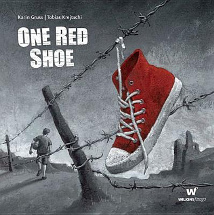One Red Shoe by Karin Gruss and Tobias Krejtschi

Wilkins Farago, 2014. ISBN 9780987109965.
(Age: Yr 5+) To the international photo journalist it's just another
call about another attack on a school bus, part of day-to-day life
on the Gaza Strip as the conflict between the Israelis and
Palestinians continues . . . 'Strange, how ordinary the message
sounded.' Little does he know that it will change his perspective
forever. As he runs past children who are so used to violence,
carnage and death that they continue their game of hopscotch
uninterrupted and play basketball against a backdrop of bombed out
buildings, he doesn't realise how the impact of doing his job -
following the victims and the paramedics into the hospital trauma
ward to give 'the people at home the most accurate information
possible' - will change him this time. For this time the victims are
children, and one in particular who keeps saying his name over and
over . . . 'Maybe children in wartime learned early on to repeat
their names even if they are unconscious, so relatives can find
them' . . . and this one touches a nerve. Through his camera lens he
sees that the boy is wearing one red basketball boot, the same as he
had given his nephew safe at home. But there is only one - where was
the other? His nephew loved his pair so surely this boy would too,
and hadn't just lost it. While its whereabouts might not be known,
it's not hard to work out what's happened to it. Little boys' legs
and grenades are not a good combination.
As he continues to shoot his pictures and the medics continue to
fight to save Kenan, something strange happens . . . something that
causes the photographer to make an important phone call and a
promise. Suddenly, this conflict just got personal.
This is one of the most powerful picture books I've read for some
time. Told in a minimalist style, almost like a photo essay would
be, the imagery is so striking that the minds connects the dots
without the need for superfluous words. Monochromatic with just the
splash of the red shoe, their style and perspective, angles and
lighting not only reinforce the idea of the narrator seeing the
events through a lens but also add to the drama and emotion of what
is being experienced. From endpaper to endpaper there is nothing
extraneous, but the astute eye will pick up tiny details that offer
so much insight into who this man is, his thoughts and emotions.
This is a picture book for older students, right through to the
senior years of secondary school. It has so many places in the
Australian Curriculum and Ian McLean's teachers'
notes offer many suggestions that demonstrate how it could be
used across all levels from about Year 5 up. An exceptional book
that has so much for so many.
Barbara Braxton